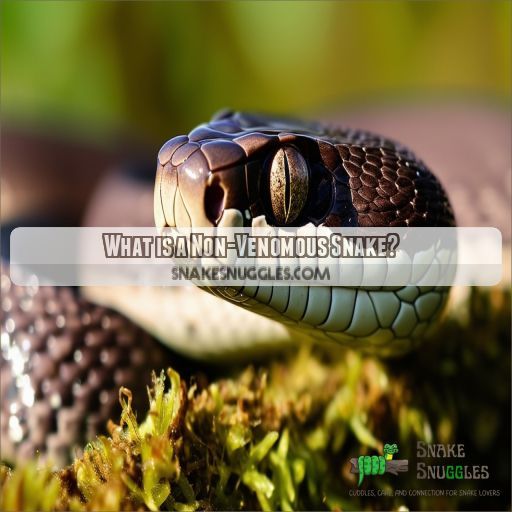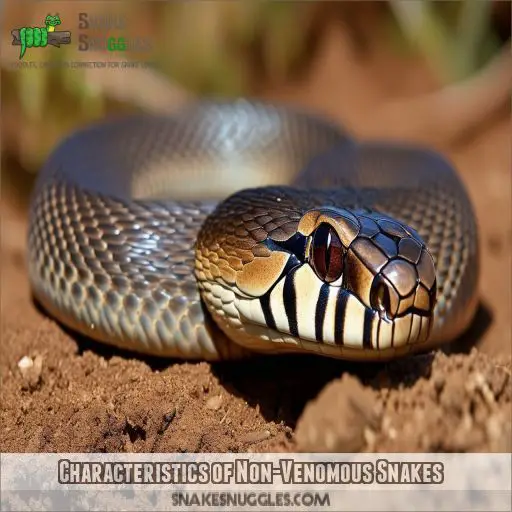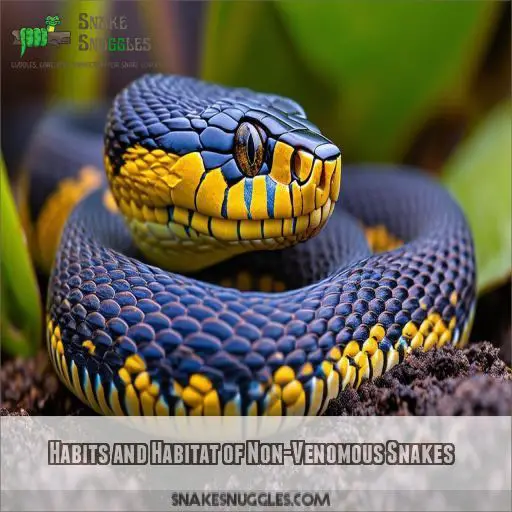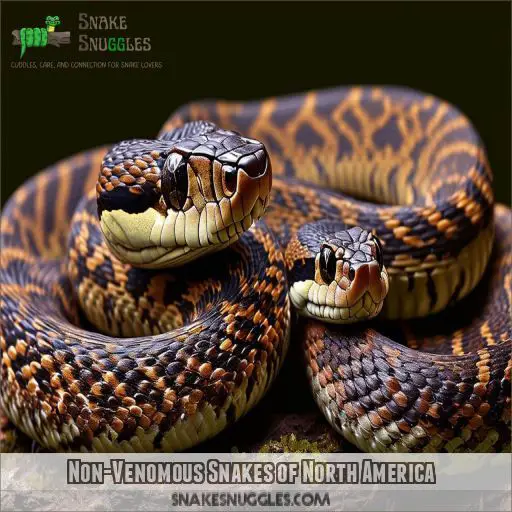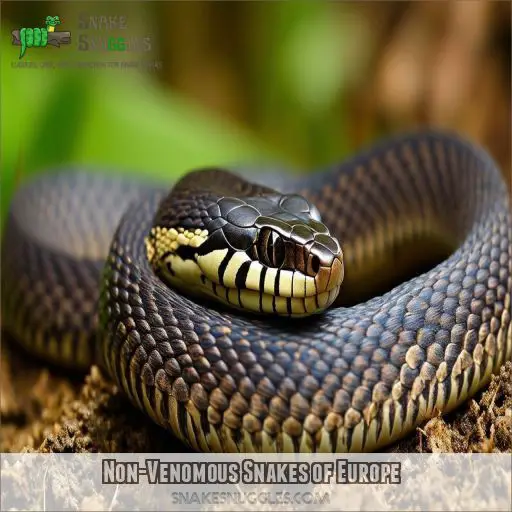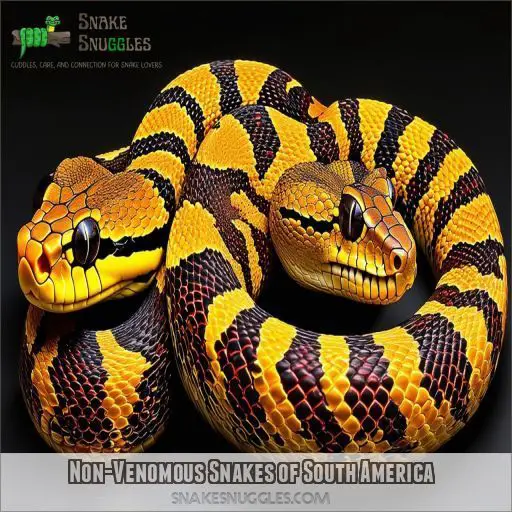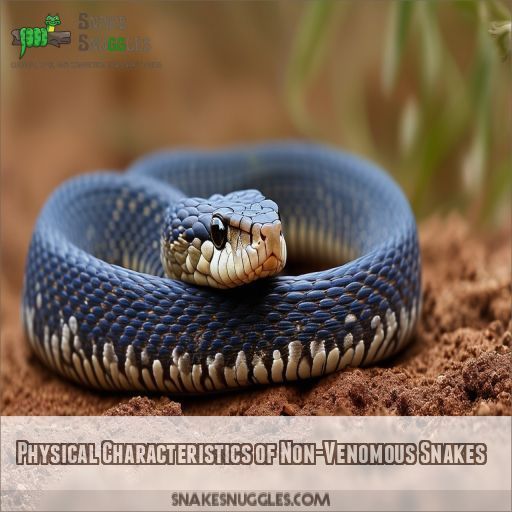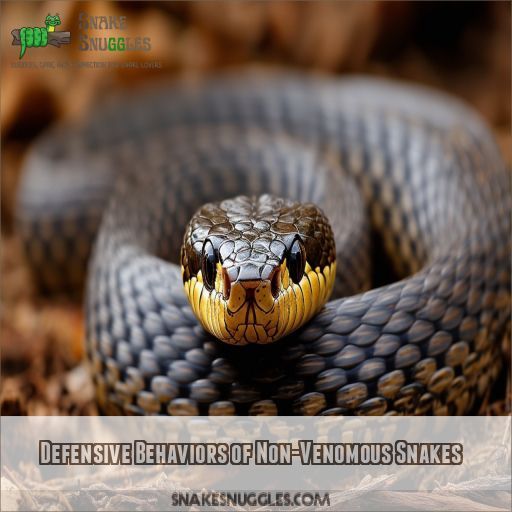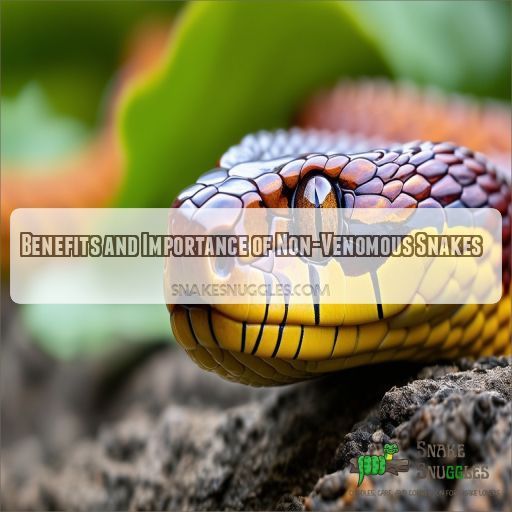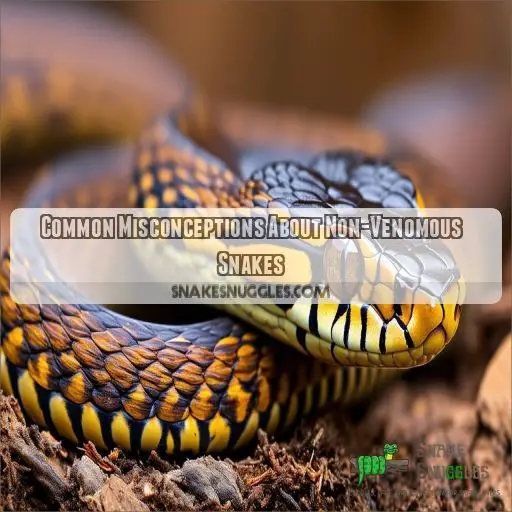This site is supported by our readers. We may earn a commission, at no cost to you, if you purchase through links.
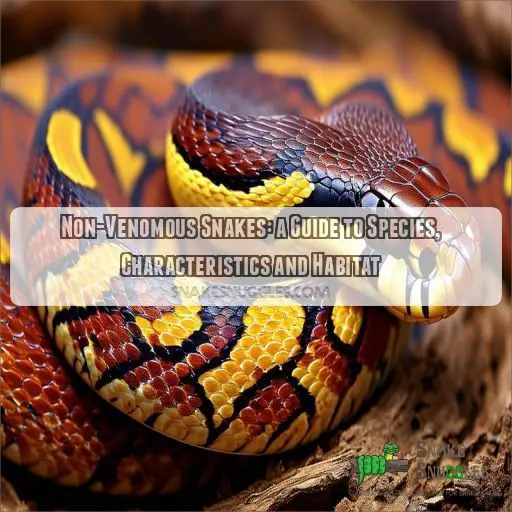 Although snakes are often feared, the truth is that only a small percentage are venomous.
Although snakes are often feared, the truth is that only a small percentage are venomous.
There’s no need to worry about the rest!
This article will take you on a journey to discover the fascinating world of non-venomous snakes.
You’ll learn about their characteristics, habitats, and the important role they play in the ecosystem.
From North America to Europe and South America, we’ll explore the diverse species that make up this group of snakes.
Table Of Contents
- Key Takeaways
- What is a Non-Venomous Snake?
- Characteristics of Non-Venomous Snakes
- Habits and Habitat of Non-Venomous Snakes
- Non-Venomous Snakes of North America
- Non-Venomous Snakes of Europe
- Non-Venomous Snakes of South America
- Physical Characteristics of Non-Venomous Snakes
- Defensive Behaviors of Non-Venomous Snakes
- Benefits and Importance of Non-Venomous Snakes
- Common Misconceptions About Non-Venomous Snakes
- Frequently Asked Questions (FAQs)
- Are smooth snakes venomous?
- What are non venomous snakes?
- What is a venomous snake?
- Are non venomous snakes dangerous?
- What kind of snakes are not poisonous?
- What is the friendliest non-venomous snake?
- What is the deadliest non-venomous snake?
- What is the definition of a non-venomous snake?
- How do non-venomous snakes defend themselves?
- Are non-venomous snakes harmful to people?
- What are the benefits of non-venomous snakes?
- Can non-venomous snakes be eaten?
- Whats the difference between venomous and poisonous snakes?
- Conclusion
Key Takeaways
- Most snakes are non-venomous and relatively harmless to humans.
- Non-venomous snakes exhibit a wide range of physical characteristics, including smooth or rough scales, vibrant colors, and unique patterns.
- These snakes play an essential role in maintaining ecological balance by regulating Rodent populations.
- While non-venomous, some snakes can still deliver a painful bite and have other defensive mechanisms, like emitting a foul smell.
What is a Non-Venomous Snake?
Non-venomous snakes are an intriguing and diverse group of reptiles that lack venom, making them relatively harmless to humans.
This doesn’t mean they’re defenceless, though. Some non-venomous snakes can still deliver a painful bite and may have other defensive mechanisms, such as emitting a foul-smelling musk or vigorously vibrating their tails.
These snakes play an essential role in maintaining ecological balance by regulating rodent populations and serving as a food source for other predators.
Understanding their behaviour and habitat is vital for effective conservation efforts and our own personal safety.
Characteristics of Non-Venomous Snakes
Non-venomous snakes come in a variety of sizes, patterns, and colors. Their scales can be smooth or rough, and their bodies can be slender or thick. These snakes are often distinguished by their unique coloration and patterns, which can include bright green (like the smooth and rough green snakes), yellow or pale with dark patterns (like the gopher snake), or even a mix of red, black, and yellow (like the milk snake).
Some non-venomous snakes, like the eastern ratsnake, have a distinctive checkerboard pattern on their bellies, while others, like the common garter snake, sport yellow stripes. The California kingsnake stands out with its rust-red body and ivory bands, and the eastern racer is known for its long, slender, athletic build.
In terms of size, non-venomous snakes can range from small, like the northern red-belly, to large, like the coachwhip, which can reach lengths of up to 6 feet. The queen snake is identified by its shorter length, usually less than 2 feet, and its yellow, cream, or peach stripes.
Habits and Habitat of Non-Venomous Snakes
Non-venomous snakes have a variety of habitat preferences and can be found in a range of environments, from sandy deserts to lush rainforests. Some species, like the garter snake, are commonly found in grassy habitats, while others, like the emerald tree boa, are tree-dwellers.
These snakes are masters of camouflage, often blending seamlessly into their surroundings with their vibrant green or yellow scales. This helps them sneak up on their prey and avoid predators.
Mating rituals vary among species, but one thing is certain: these snakes play an important role in their ecosystems. They help control rodent populations and serve as a food source for other animals.
While most non-venomous snakes prefer to avoid humans, some, like the common garter snake and the hognose snake, have adapted to living in close proximity to us. This can lead to interesting human interactions, like finding a snake in your backyard or even your house!
Non-Venomous Snakes of North America
In North America, you’ll find a variety of non-venomous snakes, each with its own unique characteristics. From the slender Ribbon Snake to the striking Northern Red-Belly, and the medium-sized Milk Snake, you’ll be introduced to a diverse range of species that call this continent home.
Eastern Ratsnake
The Eastern Ratsnake, also known as the Black Rat Snake, is a non-venomous snake species native to North America, specifically Vermont. They’re large snakes, growing between 3.5 and 7 feet long, with shiny black scales on their back and a light-colored belly. They aren’t aggressive by nature, but will flatten their heads, hiss, and coil up when threatened.
Ribbon Snake
Ribbon snakes are slender, fast-moving snakes with thin bodies that grow between 16 and 35 inches long. They’re commonly found near water, including lakes, streams, ponds, marshes, and wetlands. Ribbon snakes are semi-aquatic and excellent swimmers, often using water as an escape route from predators.
There are four recognised subspecies: the eastern ribbon snake, the northern ribbon snake, the southern ribbon snake, and the bluestripe ribbon snake. The eastern and northern ribbon snakes have brown or black bodies with white or yellow stripes, while the southern ribbon snake is tan or brown, and the bluestripe ribbon snake is dark with light blue stripes.
Northern Red-Belly
The Northern Red-Belly is a small snake, growing to about a foot in length.
It has a striking red belly, and its body is colored black and red.
This non-venomous snake is found in North America and is sometimes mistaken for the venomous coral snake.
Its prey preference includes small animals such as rodents, birds, and lizards.
The conservation status of the Northern Red-Belly is stable, and it can be locally abundant in certain habitats.
Human interactions with this snake are generally rare due to its reclusive nature and preference for less disturbed environments.
Milk Snake
Milk snakes are medium-sized, non-venomous snakes found in North America. They’ve distinctive red, black, and yellow markings, resembling the venomous coral snake. While they lack venom, milk snakes can still deliver a painful bite with their small fangs. They typically lay eggs and inhabit a variety of habitats, including forests, grasslands, and urban areas.
Northern Watersnake
The Northern Watersnake, a non-venomous species, is often found near water bodies like rivers, ponds, marshes, and lakes. With brownish or grayish scales, they can be identified by their ruddy coloring. While they may bite if disturbed, their non-venomous bites aren’t lethal.
Non-Venomous Snakes of Europe
Now, let’s slither over to Europe and shed some light on its non-venomous snakes.
The four-lined snake, or Elaphe quatuorlineata, is a species found in this region. Here are some key characteristics and facts about these fascinating creatures:
- They’re identified by their yellowish-brown bodies with four dark stripes running along their length, giving them a distinctive appearance.
- These snakes are endemic to Europe, specifically the Mediterranean region, and can be found in countries like Italy, Greece, and Albania.
- As their name suggests, they’ve four lines or stripes on their bodies, which can vary in color from dark brown to black.
- Four-lined snakes are known to inhabit a variety of habitats, including grasslands, shrublands, and forests, and they’re often found near water sources.
Stay tuned as we continue our journey and uncover the secrets of non-venomous snakes in South America next!
Non-Venomous Snakes of South America
South America is home to a variety of non-venomous snakes, including the emerald tree boa, a beautiful snake with a light green body and white irregular zigzag stripes. This tree-dwelling snake is endemic to the rainforests of South America and is an excellent example of the unique species found on this diverse continent.
The emerald tree boa is an interesting species to compare with the boa constrictor, another well-known snake native to South America. While both are non-venomous and possess similar physical characteristics, they differ in size, with the emerald tree boa typically reaching shorter lengths compared to the boa constrictor.
The emerald tree boa is generally not recommended as a pet due to its specialized habitat requirements and the difficulty in replicating its natural environment in captivity. However, with proper care and a suitable enclosure, some enthusiasts successfully keep them as pets.
In terms of conservation status, the emerald tree boa is currently listed as stable. While their population is stable, it’s important to monitor potential threats such as habitat loss and the pet trade to guarantee their long-term survival.
Physical Characteristics of Non-Venomous Snakes
Non-venomous snakes exhibit a wide range of physical characteristics that make them unique and fascinating. Here are some key physical traits to look out for:
- Coloration: Non-venomous snakes can vary in color from bright green to yellow, brown, or black, often with distinctive patterns like stripes or checkerboard designs.
- Scales: The scales of these snakes can be smooth or rough, and their texture can vary from shiny to wrinkly.
- Size: These snakes come in a variety of sizes, ranging from small, slender snakes a foot long to larger, stockier snakes that can reach over six feet in length.
Defensive Behaviors of Non-Venomous Snakes
Non-venomous snakes have evolved a variety of defensive behaviors to protect themselves from predators. These antipredator responses are vital for their survival and showcase the evolutionary pressures that have shaped their interactions with predators.
| Behavioral Adaptation | Description |
|---|---|
| Freezing | Staying still to avoid detection |
| Fleeing | Running away to escape a perceived threat |
| Striking | Biting as a last resort |
| Musk emission | Releasing a foul-smell to deter predators |
| Tail vibration | Creating a warning signal |
These defensive strategies are employed by non-venomous snakes to either avoid detection, deter predators, or, as a last resort, fight back. Freezing and fleeing are common responses to avoid confrontation, while striking and emitting musk are more aggressive behaviors when the snake feels cornered. Tail vibration is another interesting tactic, where the snake vibrates its tail against the ground to create a warning signal, similar to a rattlesnake’s rattle.
Benefits and Importance of Non-Venomous Snakes
Non-venomous snakes play an important role in maintaining a healthy ecosystem. They help control the population of their prey, such as rodents, birds, and insects, which can be agricultural pests or carry diseases. Additionally, understanding their defensive behaviours and unique physical characteristics is essential for both personal safety and effective conservation efforts.
Non-Venomous Snakes Benefits
Non-venomous snakes play a vital role in maintaining ecological balance and providing various benefits to humans and the environment. Here are some key advantages:
- Snake Ecology and Conservation: Non-venomous snakes are an essential part of the food chain, regulating populations of their prey, such as rodents, birds, and insects. They help control pest species, contributing to agricultural and ecological stability.
- Snake Identification and Safety: Learning to identify non-venomous snakes can reduce unnecessary fear and promote peaceful coexistence. Knowing their defensive behaviors, such as freezing, fleeing, or emitting musk, can help people understand their non-aggressive nature.
- Benefits to Humans: Snakes can be a valuable source of protein in some cultures and regions, providing sustenance and nutritional benefits.
- Environmental Indicators: Non-venomous snakes can serve as indicators of environmental health. Their presence or absence in an ecosystem can provide insights into habitat quality and stability, aiding scientists and conservationists in evaluating ecological changes.
- Scientific and Medical Advances: Studying non-venomous snakes contributes to scientific and medical advancements. Researching their unique digestive systems and, in the case of venomous snakes, their venom, can lead to breakthroughs in medicine and evolutionary biology.
Importance of Defensive Behaviors
Defensive behaviors are critical for non-venomous snakes to survive in the wild and coexist with humans, especially considering the challenges of wild survival for captive-bred snakes
.
These behaviors include freezing, fleeing, striking, emitting foul-smells, and tail-vibrating.
Understanding these defensive strategies is essential for snake conservation and community outreach.
It helps people identify non-venomous snakes and respond appropriately, reducing the risk of snakebites and unnecessary anti-venom use.
Additionally, knowledge of defensive behaviors can promote pet ownership of non-venomous snakes, as people can feel more confident in their ability to care for and understand these fascinating creatures.
Identifying Physical Characteristics
Identifying physical characteristics is essential when distinguishing between non-venomous and venomous snakes.
Each species has unique physical adaptations, habitat variations, and prey identification methods, making them masters of disguise in their environments.
From the slender, racing-striped ribbon snake to the brightly coloured smooth green snake, these physical traits are nature’s way of ensuring survival through effective camouflage, agility, and, in some cases, mimicry of their venomous cousins.
Common Misconceptions About Non-Venomous Snakes
Despite their harmless nature, non-venomous snakes are often misunderstood, and it’s important to dispel some common misconceptions:
- All snakes are venomous: This is a dangerous false belief. While some snakes possess venom, the majority are non-venomous and rely on constriction or other methods to subdue their prey.
- Non-venomous snakes are completely safe: Although they lack venom, some non-venomous snakes can still inflict painful bites. Respect and caution are still necessary when encountering any snake.
- Brightly colored snakes are venomous: This is a misleading generalization. Some non-venomous snakes, like the emerald tree boa, have vibrant colors, but are harmless.
- Non-venomous snakes are slow: Contrary to this, many non-venomous snakes, such as racers, are extremely agile and quick. They can climb trees and move swiftly to escape threats.
Frequently Asked Questions (FAQs)
Are smooth snakes venomous?
Smooth snakes are non-venomous and pose no risk to humans or pets. They’re constrictors, wrapping themselves around their prey to suffocate it.
What are non venomous snakes?
Non-venomous snakes are harmless to humans and can be beneficial, as they help control rodent and pest populations. Examples include the Eastern Hognose Snake, Rough Green Snake, and Eastern Yellow-bellied Racer.
What is a venomous snake?
Snakes are venomous when they produce venom, a complex mixture of toxins, to immobilize prey and defend themselves. The venom is typically delivered through hollow or grooved fangs.
Are non venomous snakes dangerous?
While non-venomous snakes aren’t dangerous in the sense of injecting venom, they can still be harmful. Some non-venomous snakes are large and powerful, like pythons, and there have been documented cases of python attacks on humans.
What kind of snakes are not poisonous?
Snakes are typically venomous, not poisonous. Non-venomous snakes include the garter snake, which is toxic to eat but not harmful to people. Other non-venomous snakes include green snakes and gopher snakes.
What is the friendliest non-venomous snake?
Captive-bred and tamed gopher snakes are considered calm for beginners. Ringneck snakes are also docile and can tolerate handling for short periods of time.
What is the deadliest non-venomous snake?
While snakes are often feared, the reality is that most are harmless to humans. The term "deadliest" is typically associated with venomous snakes, and even then, the majority of snakes are clinically non-venomous, meaning their toxins aren’t harmful to people.
What is the definition of a non-venomous snake?
A non-venomous snake is one that doesn’t produce venom. This means they don’t inject poison into another animal when they bite. Most snakes are non-venomous, but they can still be dangerous.
How do non-venomous snakes defend themselves?
A bird in the hand is worth two in the bush." Non-venomous snakes have a range of defense mechanisms, including striking and biting, camouflage, defecating, and mimicking venomous snakes.
Are non-venomous snakes harmful to people?
Most snakes are clinically non-venomous, meaning they don’t produce toxins harmful to humans. However, some non-venomous snakes can cause lacerations with their bites, so it’s best to leave them alone.
What are the benefits of non-venomous snakes?
Did you know that non-venomous snakes can prey on venomous snakes? These harmless snakes reduce the chances of human encounters with deadly reptiles. They also provide ecological benefits, such as controlling insect populations and serving as a food source for larger animals.
Can non-venomous snakes be eaten?
Yes, you can eat non-venomous snakes. In fact, they’re a valuable source of protein. Just make sure to check local regulations, as some states require a hunting license.
Whats the difference between venomous and poisonous snakes?
Venomous snakes inject their toxins through bites or stings. Poisonous snakes, on the other hand, secrete toxins that are released when they’re eaten or touched.
Conclusion
You’ve [embarked] on a journey into the [captivating] world of non-venomous snakes, uncovering their distinct traits, habitats, and ecological contributions. From the Eastern Ratsnake to the Milk Snake, these snakes showcase a variety of characteristics and behaviors across continents. While most snakes are non-venomous, caution is still advised when encountering them.

